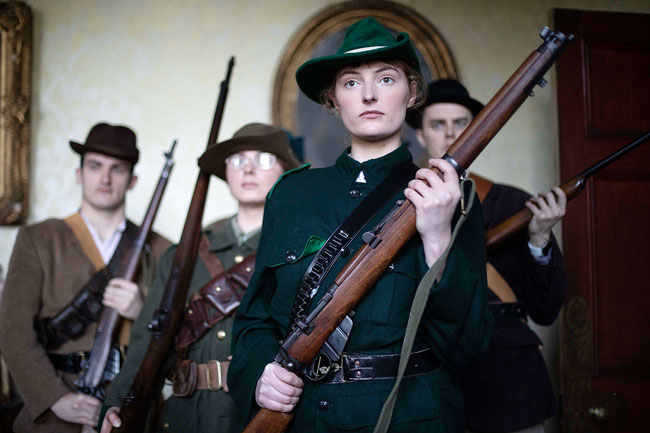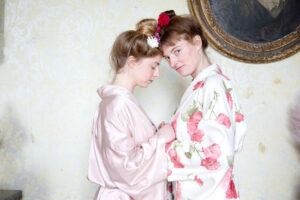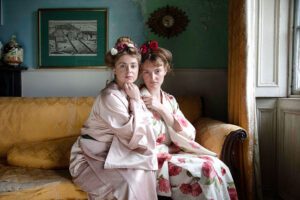Croíthe Radacacha (Radical Hearts) is a documentary about all the gay women who were at the heart of the fight for Irish independence.

It was written and directed by Cork filmmaker and fluent Irish speaker Ciara Hyland, premiered at the Galway Film Fleadh and is coming to London as part of the Irish Film Festival London.
The film focuses on several same sex relationships between radical women and the ‘love that dares not speak its name’ at the heart of the Irish Revolution. It follows Ciara’s 2021 film Forgotten: The Widows of the Irish Revolution about the widows and children of the executed 1916 leaders.
In 2020 she wrote and directed Cogadh ar Mhná/ A War on Women, based on witness testimonies, about the sexual abuse of women during the Irish Revolution. Since 2009, other documentaries she has directed for TG4 and RTÉ cover topics as far ranging as hunger strikes, epidemic diseases and political history.
Ciara told The Irish World: “I have been making history documentaries for a while, and I had come across these women tangentially and they always struck me as really fascinating. I loved everything about them – their politics, their radicalness, their bravery, their fearlessness, their courage, they really fought a good fight to make – not just Ireland – but the world a better place because they were very interconnected with a lot of the international struggles for women’s rights or labour rights.
“There was always this tantalising suggestion that they had been in same sex relationships – but no one had ever been brave enough to tackle it because it was seen as a bit of a controversial subject. It’s only recently that we have been willing to acknowledge that some of our major heroes might have been gay or LGBTQ+.
“There’s been a historic reluctance in Ireland to acknowledge that, but that tide is turning and now we’re starting to acknowledge and embrace it and there’s real cutting-edge history work being done.”
Of course, being female in this era was difficult enough.
“Mary McAuliffe, who was our historical consultant and whose research we used a lot of, makes the point that if you were a woman in history, especially if you were a radical woman in history, you’re almost twice marginalised. History has generally overlooked female stories, the women’s contribution, but then if you happen to be LGBTQ+, or you happen to be queer, and you’re female, you’re overlooked because of your gender but also because of your sexuality – it can be very difficult to uncover those stories.
“Traditionally, there’s been a reluctance to see the great heroes of Ireland and of the Irish revolution as being anything other than conservative and good Catholics – but, as a society, we’re opening up. We’re becoming more broadminded.
“You’ll always get a certain section of society that will kick back against the idea that these women were in same sex relationships, but the time is now to tell these stories.
“Ireland is in a place where Ireland can hear them and embrace them.”
So, you saw an untold story in these women who have largely been forgotten?
“Completely, the decade of centenaries that we’ve had for the last ten years in Ireland has done a lot of work to recover those stories of women that really contributed to the Irish revolution. A lot of work has been done to reclaim those stories and tell those stories – but there’s lots more that could be done.
“With this particular group of women in Radical Hearts, and they were so radical, and they were so unconventional, and they were so outside of the conservative Catholic norm. They were also on the losing side of the Civil War. They were all anti-Treaty, another reason why they were side-lined.
“Never mind the bias that historians often have (against) telling female stories, they were seen as not being as worthy as the great big leaders like Michael Collins, or De Valera or the military stories. It’s really great the amount of work that’s been done in the last decade to recover and retell those stories. We’re very nuanced in the documentary.
 “You can’t prove historical sex – ever. You can’t even prove a married couple had sex. Even if they have kids, it’s proof that the wife had sex with someone, not necessarily her husband. You can’t ever prove it, but you have to be open to the possibility of it and the weight of evidence really strongly suggests that these women were in same sex relationships.
“You can’t prove historical sex – ever. You can’t even prove a married couple had sex. Even if they have kids, it’s proof that the wife had sex with someone, not necessarily her husband. You can’t ever prove it, but you have to be open to the possibility of it and the weight of evidence really strongly suggests that these women were in same sex relationships.
“So, we are very nuanced. We present the case for it. We present the evidence for it – but we also leave room for nuance and for doubt, because obviously, you can’t ever a hundred per cent prove it. It’s enough to look at these women and say they lived their lives in radically different ways.
“They reformulated ideas of family, they reformulated ideas of what it was to live your life as a woman back at the birth of the modern Irish State, and so it’s enough to look at them and see just how unique and special and brave and courageous they were in the ways that they lived without necessarily having to put modern labels on it.”
A contributor says of Kathleen Lynn and Madeline Ffrench-Mullen’s relationship, we don’t know if they had sex – we don’t need to know that – the point is we know they were close.
“Exactly, and a relationship is more than just sex. It’s love and it’s commitment – it’s partnership, too.”
Watching the documentary, I was struck by how great these stories would be for a drama. We’ve had the films about Michael Collins etc, but aside from Countess Markievicz, I don’t recall seeing too many women of Irish history depicted…
“Absolutely. I totally agree with you. They absolutely and totally and utterly would – but there’s a couple of things about that. I’d love to make a drama of it but also they deserved a documentary be made about them. To do justice to their reality really meant something to me in this documentary, to be able to do that. I would love to make a drama out of them too but the budgets for that are so much bigger than documentary. At some point in the future, hopefully.”
There’s a line that someone says in the film, that these women were not there to make the tea or apply the bandages, they were ready to put themselves in harm’s way and even die if necessary…
“Yeah, they wanted equality. They really did. They wanted to be on a level playing field with the men, they very much wanted to be seen as equals. They wanted to fight as well, this particular group of women weren’t ever really going to take second place to men and that was why they ended up anti-Treaty, because they saw the Treaty as selling out the equality for women, equality for everybody, that had been part of the 1916 Proclamation.
“They saw that the treaty as a watering down of that, and history proved them right. Ireland became a very conservative place that relegated women to the home. We saw that happen. They saw that coming, they saw the writing on the wall – that’s partly the reason they fought against it.”
Kathleen Lynn is a fascinating character. When the Rising failed she could have said she was a doctor but professed to being part of the rebellion..
 “Yeah, she could have claimed the identity of a doctor – because she was one – but instead, she identified herself as a captain of the garrison. She wanted to be seen as a combatant and she wanted to be seen as part of the military uprising. It is very interesting how they understood how identity operated, it’s a very modern concept that we deal with now, but they already had a strong idea of it back then.”
“Yeah, she could have claimed the identity of a doctor – because she was one – but instead, she identified herself as a captain of the garrison. She wanted to be seen as a combatant and she wanted to be seen as part of the military uprising. It is very interesting how they understood how identity operated, it’s a very modern concept that we deal with now, but they already had a strong idea of it back then.”
Margaret Skinnider was also an example of that, she disguised herself as a man.
“For me they’re totally fascinating, and they feel so modern and so relevant to today. They really speak to us today in their idea of gender politics and gender identity and they were the first generation to really question, really try to come to terms with that and grapple with those questions and play with it.
“I love Margaret Skinnider, I absolutely love Margaret Skinnider. She’s one of my favourites. She learned how to fire a gun in a rifle club, she was a leader, she was a sniper in 1916. She had men under her command who totally respected her.
“She was the only woman injured in combat – she was shot in the leg – but she was also really, really competent at disguising herself as a boy and taking on a male identity to outwit the British and run messages and smuggle guns. She understood how gender operated, she’s totally fascinating. I absolutely adore her. I could do a whole film on Margaret Skinnider alone.”
One history book included a picture of Margaret Skinnider disguised as a man but airbrushed out the women on either side of her… why?
“It was probably too queer to have a woman dressed as a man with a woman on either arm – it just raised uncomfortable questions. There were maybe uncomfortable questions already being raised about her gender and sexuality to begin, so they airbrushed it out – but we’ve put it back in.”
The aim of the film is to bring to light forgotten stories and forgotten figures of history…
“Exactly, but that’s my work always. My previous documentaries were very much about that. I made one on sexual violence against women in the Irish revolution. That was about women’s testimonies, they had given testimonies in diaries or letters or to the courts or to the police – they weren’t believed at the time.
“We took that testimony and brought it to light again. That was a very important documentary to me. We also made one on the widows and children of the men who were executed in 1916 because nobody ever goes, ‘What the Hell happened to them?’
“Everybody knows what happened to their husbands, but nobody knows what happened to the families they left behind, who really struggled without their breadwinners. They were enemies of the State, as well. They were enemies of the British State because we were still under British rule, so they were targeted for violence and for raids.
“Some of them had very small kids and really struggled financially. The Nationalist community did rally around and look after them, but it was still extremely tough.
“So, my work is always about, where’s the hidden story? Where are the voices that haven’t been given space or time yet? Where are the people who’ve been neglected and left out of the narrative?
A touching part of the documentary is the death of Sean Connolly, witnessed by Helena Molony and Kathleen Lynn, who tried to treat him, and his 15-year-old brother. Because we read about them in history books we forget these were real people (with families)…
“The trauma of it as well. They would have known him for quite a long time before the Rising and so to see somebody you know very well shot and die in front of you in the opening moments of the Rising, that’s got to be super traumatic.
“We gloss over the sheer amount of trauma most of the people who fought in 1916, and in the Irish Revolution and the Civil War afterwards, must have gone through.”
You also took on the story of Terence MacSwiney in the TV movie 74 Days…
“Terence MacSwiney is somebody else who totally fascinated me – how do you make the decision and have the willpower to starve yourself to death for a cause? It’s the ultimate in passive resistance, the ultimate sacrifice you can make really for something that you believe in.
“People as diverse as Ho Chi Minh in Vietnam, and Nelson Mandela, and several other people, all quoted him as an inspiration in terms of a model of passive resistance. Obviously, he hurt his family and his wife and child by doing it but at the same time, he didn’t go out and kill somebody or bomb somebody. It’s a very moral thing, to starve yourself to death for your principles – he carried it right through to the end.”
You’re quite pleased the film is being shown in London…
“I’m so chuffed. It means a lot actually, that they are screening it.”
- Croíthe Radacacha/Radical Hearts will be shown at 6.30pm on Saturday 18 November at the London Irish Centre in Camden as part of the Irish Film Festival London. For more see iftuk.com.


